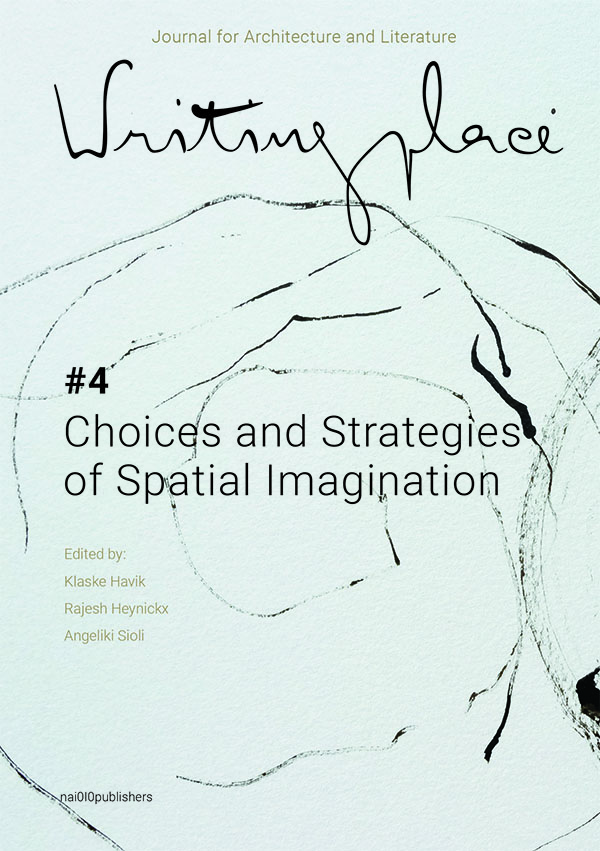Authors
-
Klaske Havik
TU Delft, Architecture and the Built Environment
-
Angeliki Sioli
TU Delft, Architecture and the Built Environment
-
Rajesh Heynickx
KU Leuven, Architectural Theory and Intellectual History
Abstract
Architecture is by definition an act of spatial imagination, this wondrous capacity to envision possible futures for the built environment. Spatial imagination is essential in order to visualize new constructions taking shape, evolving in time, and partaking of the cultural expression of a place or era. It takes spatial imagination to foresee how architecture can meaningfully contribute to people’s lives, providing a sense of belonging, space for their needs and dreams. Nonetheless, spatial imagination is oftentimes hard to trigger or difficult to control. Imaginative ideas often emerge unexpectedly, when seemingly unconnected or contradictory words, images and thoughts are brought together. Spatial imagination, just like the creative act of writing, seems to reside in ‘the lightning flashes of the mental circuits that capture and link points distant from each other in space and time,’1 as Italo Calvino poetically claims.
The topic of this fourth issue of Writingplace journal, Choices and Strategies of Spatial Imagination, ‘links points distant from each other’, by connecting texts from different disciplines with architectural design, in order to study imagination. This issue starts from a paradoxical observation: although we recognize, almost spontaneously, the paramount role spatial imagination plays in the creation of an inspired built environment, there is admittedly limited emphasis on the detailed study of this creative imagination in the field of architectural research. Moreover, a lack of rigorous reflection on the key role of spatial imagination in addressing the urban and architectural issues that are currently at stake in our societies can be detected across all of the design disciplines. For example, there is surprisingly little attention for how specialties outside architecture can inform or inspire the proliferation of spatial imagination. It seems, as William Whyte argued, that we have forgotten that ‘we are always translating architecture: not reading its message, but exploring its multiple transpositions’. The issue focuses precisely on different kinds of transpositions between written forms of imagination and architecture, but without defending the popular belief that we should read architecture as a polysemic text and start to think in terms like ‘architexture’ or ‘polygraphy’ when analysing architecture culture.
Author Biographies
Klaske Havik, TU Delft, Architecture and the Built Environment
Klaske Havik is professor of architecture, Methods of Analysis & Imagination at Delft University of Technology. She studied architecture in Delft and Helsinki and literary writing in Amsterdam. She has developed a distinct research approach relating architectural and urban questions (such as the use, experience and imagination of place) to literary language. Her book Urban Literacy: Reading and Writing Architecture (2014), based on her PhD research, developed a literary approach to architecture. She initiated the platform Writingplace and organized the international conference Writingplace: Literary Methods in Architectural Research and Design in 2013. The book Writingplace: Investigations in Architecture and Literature appeared in 2016. Klaske Havik is editor of OASE, Journal for Architecture. Havik’s literary work has appeared in Dutch poetry collections and literary magazines.
Angeliki Sioli, TU Delft, Architecture and the Built Environment
Angeliki Sioli is assistant professor, Chair of Methods of Analysis and Imagination, Faculty of Architecture and the Built Environment Delft University of Technology. She is former assistant professor of architecture at Louisiana State University, USA, and a licensed architect in Greece. She has taught courses at University Tec de Monterrey in Mexico and McGill University in Canada, where she completed her PhD in history and theory of architecture in 2015. Her research seeks connections between architecture and literature in the public realm of the early twentieth-century European city while also looking into pedagogical aspects of architectural education. It has been published in a number of edited books and journals, as well as presented at interdisciplinary conferences. It also appears in the book she recently co-edited titled Reading Architecture: Literary Imagination and Architectural Experience (Routledge, 2018). The volume touches on the interdisciplinary field of architecture and literature and was the outcome of the international symposium of the same name she co-organized in Athens, Greece in 2015.
Rajesh Heynickx, KU Leuven, Architectural Theory and Intellectual History
Rajesh Heynickx is a professor in Architectural Theory and Intellectual History at the KU Leuven. He has published articles in Modern Intellectual History, Modernist Cultures, Environment and History and Architectural Theory Review, among others. In 2020 he edited, together with Hilde Heynen and Sebastian Loosen, the volume The Figure of Knowledge. Conditioning Architectural Theory, 1960s-1990s. (Leuven University Press). In the same year, he co-edited Architecture Thinking Across Boundaries: Knowledge Transfers since the 1960s (Bloomsbury). At the KU Leuven Department of Architecture, he is spokesman of the FWO-Scientific Research Network “Texts ≈ Buildings: Dissecting Transpositions in Architectural Knowledge (1880-1980)” from which this special issue results.
References
Italo Calvino Six Memos for the Next Milennium, translated by Patrick Creagh (London: Vintage, 1996), 48.
William Whyte, ‘How Do Buildings Mean? Some Issues of Interpretation in the History of Architecture’, History and Theory 45/2 (2006), 153.
David Spurr, ‘An End to Dwelling: Reflections on Modern Literature and Architecture’, in: Astradur Eysteinsson and Vivian Liska (eds.), Modernism
(Amsterdam/Philadelphia: John Benjamins, 2007), 469-486.
Jorge Otero-Pailos, Architecture’s Historical Turn: Phenomenology and the Rise of the Postmodern (Minneapolis: University of Minnesota Press, 2010), 15-38.



